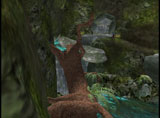 We all fall victim to
fits of nostalgia from time to time. For me, I’ve always had a soft spot for fantasy
games, a result of my childhood, my first game console, and Zelda. Since that time, few
games have come close to topping the lasting enjoyment I received from that green-hat
totting, sword wielding little elf person. Some would say that most games just don’t
have the staying power anymore. I think that maybe I was simply easier to amuse back then.
Whatever the reason, when Azurik: Rise of Perathia came through our doors, flashing what
looked to be fantasy-like images and an impressive array of mystical sceneries; I asked my
editor for it. Perhaps I wasn’t looking for another Zelda, but with Project Ego still
months from release, and with the Xbox’s recent entrance onto the world show floor, I
couldn’t help but take a tentative look at the first run fantasy games that have come
out for it.
We all fall victim to
fits of nostalgia from time to time. For me, I’ve always had a soft spot for fantasy
games, a result of my childhood, my first game console, and Zelda. Since that time, few
games have come close to topping the lasting enjoyment I received from that green-hat
totting, sword wielding little elf person. Some would say that most games just don’t
have the staying power anymore. I think that maybe I was simply easier to amuse back then.
Whatever the reason, when Azurik: Rise of Perathia came through our doors, flashing what
looked to be fantasy-like images and an impressive array of mystical sceneries; I asked my
editor for it. Perhaps I wasn’t looking for another Zelda, but with Project Ego still
months from release, and with the Xbox’s recent entrance onto the world show floor, I
couldn’t help but take a tentative look at the first run fantasy games that have come
out for it. 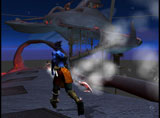 Unfortunately, while Azurik offers some of the most imaginative
world design I’ve seen in a long time, it offers far too much repetitive game play
and far too little accompanying storyline to be awarded a very high rating. Though not
lacking in some interesting details, the list of complaints reads like an extended laundry
list of unpleasant clothes, ranging from minor problems with lighting, to major
difficulties with an antique saving system and miserable controls. When it comes down to
it, Azurik’s visuals and magic system offers some ups, but its numerous flaws limit
it to no more than a two star rating; a score reserved for games worth very little of your
time.
Unfortunately, while Azurik offers some of the most imaginative
world design I’ve seen in a long time, it offers far too much repetitive game play
and far too little accompanying storyline to be awarded a very high rating. Though not
lacking in some interesting details, the list of complaints reads like an extended laundry
list of unpleasant clothes, ranging from minor problems with lighting, to major
difficulties with an antique saving system and miserable controls. When it comes down to
it, Azurik’s visuals and magic system offers some ups, but its numerous flaws limit
it to no more than a two star rating; a score reserved for games worth very little of your
time.
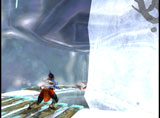 As Azurik, a lore guardian, it is your responsibility to travel the six realms
of Perathia in order to recover the missing elemental disks, which were lost when your
archenemy betrayed you and your fellow guardians. You control your character from the
perspective of a movable camera that you control with your right joystick. The game begins
with a brief tutorial, an explanation of how to use Azurik’s powers (which I’ll
get into later), and a short training session with "the ultimate weapon", which
turns out to be a staff with blades at each end.
As Azurik, a lore guardian, it is your responsibility to travel the six realms
of Perathia in order to recover the missing elemental disks, which were lost when your
archenemy betrayed you and your fellow guardians. You control your character from the
perspective of a movable camera that you control with your right joystick. The game begins
with a brief tutorial, an explanation of how to use Azurik’s powers (which I’ll
get into later), and a short training session with "the ultimate weapon", which
turns out to be a staff with blades at each end.
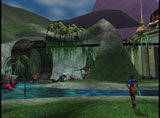 Immediately, you’ll notice one of Azurik’s most important drawbacks.
The camera controls are simply poorly designed. The job of fighting a creature and
controlling the camera simultaneously is one that will have the most ambidextrous of us
cursing in frustration. Since the view doesn’t swivel to face with your character, or
alternatively, it does when you don’t want it to, you often find yourself retreating
from creatures you can no longer see as you try to move to a more strategic position, or
falling to your death from an obvious cliff for no reason besides that you couldn’t
get your camera in the right place in time. Combined with this is the fact that the
controls themselves are rather poor, as most people will notice the first time they
attempt to walk up one of the many narrow paths that they are forced to walk without
plunging to their doom. The difficult controls are more annoying when one considers that a
majority of your time in the game will be spent either jumping from one platform to
another, or balancing on a narrow pathway, both of which are severely hampered by the
ineptitude of the control design.
Immediately, you’ll notice one of Azurik’s most important drawbacks.
The camera controls are simply poorly designed. The job of fighting a creature and
controlling the camera simultaneously is one that will have the most ambidextrous of us
cursing in frustration. Since the view doesn’t swivel to face with your character, or
alternatively, it does when you don’t want it to, you often find yourself retreating
from creatures you can no longer see as you try to move to a more strategic position, or
falling to your death from an obvious cliff for no reason besides that you couldn’t
get your camera in the right place in time. Combined with this is the fact that the
controls themselves are rather poor, as most people will notice the first time they
attempt to walk up one of the many narrow paths that they are forced to walk without
plunging to their doom. The difficult controls are more annoying when one considers that a
majority of your time in the game will be spent either jumping from one platform to
another, or balancing on a narrow pathway, both of which are severely hampered by the
ineptitude of the control design.
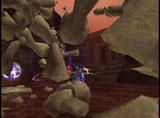 That said, there is one element in which the controls work relatively well, and
that is in the execution of basic combat. Camera controls aside, Azurik wields his staff
like a true master, using both ends to strike out at his enemies on either side of him. I
once read that the staff was a far more effective weapon than the sword, if not for the
space that it required to use it. Azurik demonstrates why. Often faced with multiple
enemies from multiple angles, Azurik’s ability to stun an enemy and than strike
another at a different location is very useful. The controls for this are adequately done,
once you get used to them.
That said, there is one element in which the controls work relatively well, and
that is in the execution of basic combat. Camera controls aside, Azurik wields his staff
like a true master, using both ends to strike out at his enemies on either side of him. I
once read that the staff was a far more effective weapon than the sword, if not for the
space that it required to use it. Azurik demonstrates why. Often faced with multiple
enemies from multiple angles, Azurik’s ability to stun an enemy and than strike
another at a different location is very useful. The controls for this are adequately done,
once you get used to them.
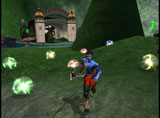 An addition to the game that works to its benefit is the magic system. Azurik
can’t cast spells, but he can call upon the elements to assist him once he gathers
the right objects in the game. Different powers can be called upon by combining the
elements to produce different effects. Water and fire combine to make steam, which covers
the ends of your staff as you pummel enemies over the head. The discovery of new powers is
one of the most rewarding parts of the game. Sadly, aside from the powers, combat quickly
becomes repetitive - to the point that you find yourself avoiding enemies rather than
fighting them. Indeed, they are rarely more than mere obstacles as you explore, without
any explanation from the game of why they are attacking you, or why you even have to
interact with them.
An addition to the game that works to its benefit is the magic system. Azurik
can’t cast spells, but he can call upon the elements to assist him once he gathers
the right objects in the game. Different powers can be called upon by combining the
elements to produce different effects. Water and fire combine to make steam, which covers
the ends of your staff as you pummel enemies over the head. The discovery of new powers is
one of the most rewarding parts of the game. Sadly, aside from the powers, combat quickly
becomes repetitive - to the point that you find yourself avoiding enemies rather than
fighting them. Indeed, they are rarely more than mere obstacles as you explore, without
any explanation from the game of why they are attacking you, or why you even have to
interact with them.
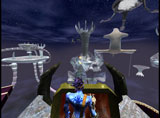 The lack of explanation is characteristic of the entire game. Though it is true
that the scenery in Azurik is both imaginative and colorful, it is accompanied with none
of the explanations, or lore, that would make it truly interesting. For example, the world
is populated with tremendous machines that you must make function in order to progress.
Underground caves with tubes abound. But where did they come from? What purpose did they
serve? Who built them? The brief one page description included in the manual is limited,
and also the last word on the subject. While Azurik wanders in a world rich with creative
wonder, the story of who built these wonderful and exotic locations seems to play almost
no role in the actual game play. Why the storyline isn’t incorporated into the game
execution is beyond me, since a journey that somehow informed the player of a deep and
rich world would have been so much more interesting than what is currently in place.
The lack of explanation is characteristic of the entire game. Though it is true
that the scenery in Azurik is both imaginative and colorful, it is accompanied with none
of the explanations, or lore, that would make it truly interesting. For example, the world
is populated with tremendous machines that you must make function in order to progress.
Underground caves with tubes abound. But where did they come from? What purpose did they
serve? Who built them? The brief one page description included in the manual is limited,
and also the last word on the subject. While Azurik wanders in a world rich with creative
wonder, the story of who built these wonderful and exotic locations seems to play almost
no role in the actual game play. Why the storyline isn’t incorporated into the game
execution is beyond me, since a journey that somehow informed the player of a deep and
rich world would have been so much more interesting than what is currently in place.
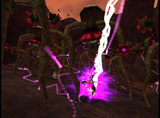 This lack of attention to certain details is not limited to the storyline. It
makes appearances in other aspects of the game as well. When you fall to your death (by
far the most common way to die) your character hits the ground, stands up as if fine, and
then falls over dead as if he were somehow mortally wounded after the fact. Lighting
throughout the game is oddly done, leaving you wandering blind in dark caves, able to see
yourself and enemies as if in broad daylight, but unable to distinguish rock from open
air. Since your character runs the same regardless of whether or not he is running into a
rock or open air, this can sometimes present a problem.
This lack of attention to certain details is not limited to the storyline. It
makes appearances in other aspects of the game as well. When you fall to your death (by
far the most common way to die) your character hits the ground, stands up as if fine, and
then falls over dead as if he were somehow mortally wounded after the fact. Lighting
throughout the game is oddly done, leaving you wandering blind in dark caves, able to see
yourself and enemies as if in broad daylight, but unable to distinguish rock from open
air. Since your character runs the same regardless of whether or not he is running into a
rock or open air, this can sometimes present a problem.
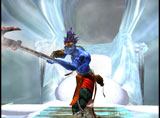 On the up side, the world of Perathia is vast, and not uninteresting. The back
of the box states that it provides "non-linear game play [that] allows you to run
freely from realm to realm." This is true, but the non-linear game play gives you
very limited clues about where you are supposed to be going. You often find yourself
leaving an area uncertain you’ve accomplished everything you are required to do
there, only to find out two hours later that you have to work your way back because you
did indeed miss a key item. Since the world is so vast, and so much of it is dominated by
jumping puzzles, backtracking is an annoying, but absolutely imbedded, aspect of the game.
You’ll often find yourself wandering in circles, covering territory you’ve
covered time and time again in search of where you are supposed to go next. Part of the
vast feel of the land comes simply from the inability to progress through it fast. A lack
of direction is sure to slow you down.
On the up side, the world of Perathia is vast, and not uninteresting. The back
of the box states that it provides "non-linear game play [that] allows you to run
freely from realm to realm." This is true, but the non-linear game play gives you
very limited clues about where you are supposed to be going. You often find yourself
leaving an area uncertain you’ve accomplished everything you are required to do
there, only to find out two hours later that you have to work your way back because you
did indeed miss a key item. Since the world is so vast, and so much of it is dominated by
jumping puzzles, backtracking is an annoying, but absolutely imbedded, aspect of the game.
You’ll often find yourself wandering in circles, covering territory you’ve
covered time and time again in search of where you are supposed to go next. Part of the
vast feel of the land comes simply from the inability to progress through it fast. A lack
of direction is sure to slow you down.
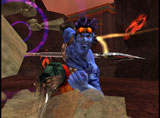 Being forced to re-track your footsteps would not be so unpleasant if the
monsters, merely obstacles to slow you down to begin with, didn’t re-spawn every time
you die and reload the game. This means that when you backtrack, not only do you cover the
same territory, but you must also vanquish the same enemies over and over again. Saving is
done by finding checkpoints that are often far too distant from one another. Falling to
your death can be all the more frustrating when it happens twenty minutes from your last
save point, over hills, canyons, and ten little floating islands that took you four hours
to cross the first time. This aspect of the game, to say the least, sucks. It is
antiquated, frustrating, and limiting. There are few things more annoying than working
your way an hour into a game, only to find yourself late for an appointment and unable to
turn off the game for lack of the ability to save.
Being forced to re-track your footsteps would not be so unpleasant if the
monsters, merely obstacles to slow you down to begin with, didn’t re-spawn every time
you die and reload the game. This means that when you backtrack, not only do you cover the
same territory, but you must also vanquish the same enemies over and over again. Saving is
done by finding checkpoints that are often far too distant from one another. Falling to
your death can be all the more frustrating when it happens twenty minutes from your last
save point, over hills, canyons, and ten little floating islands that took you four hours
to cross the first time. This aspect of the game, to say the least, sucks. It is
antiquated, frustrating, and limiting. There are few things more annoying than working
your way an hour into a game, only to find yourself late for an appointment and unable to
turn off the game for lack of the ability to save.
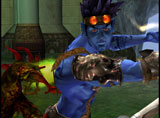 Additionally, there is a lack of adjustability. The difficult controls cannot
be re-mapped or customized, there isn’t any difficulty settings, and all narration is
audio with no ability to turn on sub captions. You merely put the game in, turn on the
Xbox, and press start. In game options let you adjust various sound volume, but nothing
more. Finally, designed solely for the Xbox, there is little excuse to have obvious lag.
Yet there are numerous times, particularly near waterfalls and plums of dust, when the
system noticeably slows down.
Additionally, there is a lack of adjustability. The difficult controls cannot
be re-mapped or customized, there isn’t any difficulty settings, and all narration is
audio with no ability to turn on sub captions. You merely put the game in, turn on the
Xbox, and press start. In game options let you adjust various sound volume, but nothing
more. Finally, designed solely for the Xbox, there is little excuse to have obvious lag.
Yet there are numerous times, particularly near waterfalls and plums of dust, when the
system noticeably slows down.
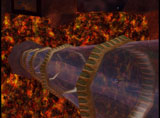 Ultimately, Azurik carries too little punch for a long hall. While the imagery
is immediately interesting and draws the player in, that interest dwindles when it becomes
evident that the neat elements never really play a more significant role than that of
background images. Without a significant storyline that integrates into the game play, and
with difficult controls, difficult cameras, and a difficult save feature, Azurik falls
short of being what could have been a very interesting game. While the world design will
draw you back from time to time, the repetitive style of combat and aimless world
wandering will leave you frustrated, since it can take a lot of wandering to make it
anywhere. Not without its good sides, Azurik simply falls short. If you’re looking
for a good fantasy game, I’d recommend holding out for the release of those that are
sure to come farther down the road. I’m still keeping my eyes open, because I
didn’t find it here.
Ultimately, Azurik carries too little punch for a long hall. While the imagery
is immediately interesting and draws the player in, that interest dwindles when it becomes
evident that the neat elements never really play a more significant role than that of
background images. Without a significant storyline that integrates into the game play, and
with difficult controls, difficult cameras, and a difficult save feature, Azurik falls
short of being what could have been a very interesting game. While the world design will
draw you back from time to time, the repetitive style of combat and aimless world
wandering will leave you frustrated, since it can take a lot of wandering to make it
anywhere. Not without its good sides, Azurik simply falls short. If you’re looking
for a good fantasy game, I’d recommend holding out for the release of those that are
sure to come farther down the road. I’m still keeping my eyes open, because I
didn’t find it here.
